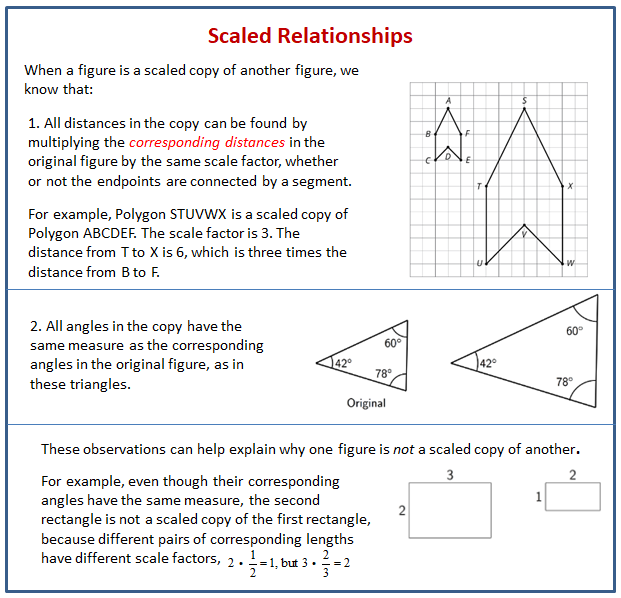Illustrative Mathematics Grade 7, Unit 1, Lesson 4: Scaled Relationships
Learning Targets:
- I can use corresponding distances and corresponding angles to tell whether one figure is a scaled copy of another.
- When I see a figure and its scaled copy, I can explain what is true about corresponding angles.
- When I see a figure and its scaled copy, I can explain what is true about corresponding distances.
Related Pages
Illustrative Math
Grade 7
Lesson 4: Scaled Relationships
Let’s find relationships between scaled copies.
Illustrative Math Unit 7.1, Lesson 4 (printable worksheets)
Lesson 4 Summary
The following diagram describes how to use corresponding distances and corresponding angles to tell whether one figure is a scaled copy of another.

Lesson 4.1 Three Quadrilaterals (Part 1)
Each of these polygons is a scaled copy of the others.
- Name two pairs of corresponding angles. What can you say about the sizes of these angles?
- Check your prediction by measuring at least one pair of corresponding angles using a protractor. Record your measurements to the nearest 5.
Lesson 4.2 Three Quadrilaterals (Part 2)
Each of these polygons is a scaled copy of the others. You already checked their corresponding angles.
- The side lengths of the polygons are hard to tell from the grid, but there are other corresponding distances that are easier to compare. Identify the distances in the other two polygons that correspond to DB and AC, and record them in the table.
- Look at the values in the table. What do you notice?
Pause here so your teacher can review your work. - The larger figure is a scaled copy of the smaller figure.
a. If AE = 4, how long is the corresponding distance in the second figure? Explain or show your reasoning.
b. If IK = 5, how long is the corresponding distance in the first figure? Explain or show your reasoning.
Lesson 4.3 Scaled or Not Scaled?
Here are two quadrilaterals.
- Mai says that Polygon ZSCH is a scaled copy of Polygon XJYN, but Noah disagrees. Do you agree with either of them? Explain or show your reasoning.
- Record the corresponding distances in the table. What do you notice?
- Measure at least three pairs of corresponding angles in XJYN and ZSCH using a protractor. Record your measurements to the nearest 5. What do you notice?
- Do these results change your answer to the first question? Explain.
Here are two more quadrilaterals. - Kiran says that Polygon EFGH is a scaled copy of ABCD, but Lin disagrees. Do you agree with either of them? Explain or show your reasoning.
Are you ready for more?
All side lengths of quadrilateral MNOP are 2, and all side lengths of quadrilateral QRST are 3. Does QRST have to be a scaled copy of MNOP? Explain your reasoning
-
Show Answers
In order for QRST to be a scaled copy of MNOP, the corresponding angles must be equal as well.
Lesson 4.4 Comparing Pictures of Birds
Here are two pictures of a bird. Find evidence that one picture is not a scaled copy of the other. Be prepared to explain your reasoning. See Birds
Lesson 4 Practice Problems
- Select all the statements that must be true for any scaled copy Q of Polygon P.
A. The side lengths are all whole numbers. B. The angle measures are all whole numbers. C. Q has exactly 1 right angle. D. If the scale factor between P and Q is 1/2, then each side length of P is multiplied by 1/5 to get the corresponding side length of Q. E. If the scale factor is 2, each angle in P is multiplied by 2 to get the corresponding angle in Q. F. Q has 2 acute angles and 3 obtuse angles. - Here is Quadrilateral ABCD. Quadrilateral PQRS is a scaled copy of Quadrilateral ABCD. Point P corresponds to A, Q to B, R to C, and S to D. If the distance from P to R is 3 units, what is the distance from Q to S? Explain your reasoning.
- Figure 2 is a scaled copy of Figure 1. a. Identify the points in Figure 2 that correspond to the points A and C in Figure 1. Label them P and R. What is the distance between P and R? b. Identify the points in Figure 1 that correspond to the points Q and S in Figure 2. Label them B and D. What is the distance between B and D? c. What is the scale factor that takes Figure 1 to Figure 2? d. G and H are two points on Figure 1, but they are not shown. The distance between G and H is 1. What is the distance between the corresponding points on Figure 2?
- To make 1 batch of lavender paint, the ratio of cups of pink paint to cups of blue paint is 6 to 5. Find two more ratios of cups of pink paint to cups of blue paint that are equivalent to this ratio.
The Open Up Resources math curriculum is free to download from the Open Up Resources website and is also available from Illustrative Mathematics.
Try out our new and fun Fraction Concoction Game.
Add and subtract fractions to make exciting fraction concoctions following a recipe. There are four levels of difficulty: Easy, medium, hard and insane. Practice the basics of fraction addition and subtraction or challenge yourself with the insane level.

We welcome your feedback, comments and questions about this site or page. Please submit your feedback or enquiries via our Feedback page.